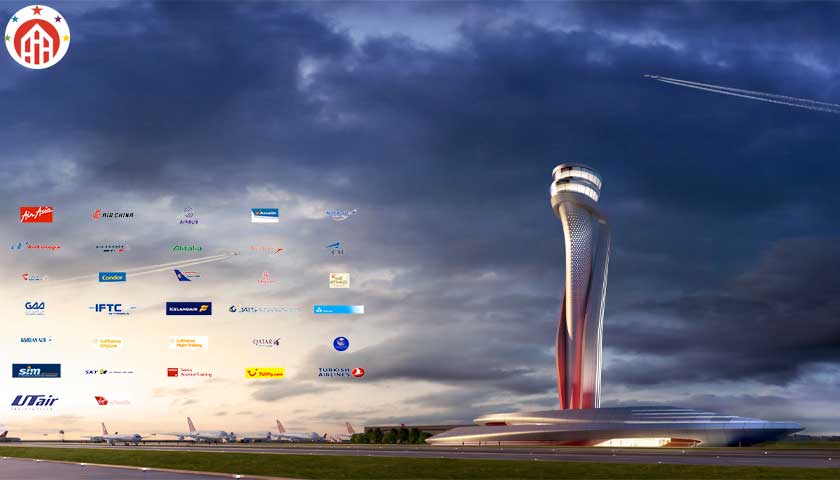Top 10 Airports in the World: Readers’ Choice Awards 2021
Condé Nast Traveler has revealed its World’s Top 10 Airports for 2021 and the reigning champion has been dethroned.
An airport is an aerodrome with extended facilities, mostly for commercial air transport. Airports often have facilities to park and maintain aircraft, and a control tower. An airport consists of a landing area, which comprises an aerially accessible open space including at least one operationally active surface such as a runway for a plane to take off and to land or a helipad, and often includes adjacent utility buildings such as control towers, hangars and terminals. Larger airports may have airport aprons, taxiway bridges, air traffic control centres, passenger facilities such as restaurants and lounges, and emergency services. In some countries, the US in particular, airports also typically have one or more fixed-base operators, serving general aviation.
Operating airports is extremely complicated, with a complex system of aircraft support services, passenger services, and aircraft control services contained within the operation. Thus airports can be major employers, as well as important hubs for tourism and other kinds of transit. Because they are sites of operation for heavy machinery, a number of regulations and safety measures have been implemented in airports, in order to reduce hazards. Additionally, airports have major local environmental impacts, as both large sources of air pollution, noise pollution and other environmental impacts, making them sites that acutely experience the environmental effects of aviation. Airports are also vulnerable infrastructure to extreme weather, climate change caused sea level rise and other disasters.
For many international travelers, their trip begins the moment they arrive at an airport abroad. And entering a country from any of these top 10 international gateways ensures your journey will get off to a smooth start. Many of them have undergone dramatic transformations in recent years, as various famous architects worked their magic, creating bright and airy spaces, with amenities ranging from spas and yoga rooms to outdoor gardens and swimming pools. These terminals are such an antidote to jet lag, you might even want to extend your layover. Read on to see how the votes stacked up in our 33rd edition of our annual Readers’ Choice Awards.
1. Singapore (SIN) 89.58
Singapore Changi Airport, commonly known as Changi Airport (IATA: SIN, ICAO: WSSS), is a major civilian airport that serves Singapore and one of the largest transportation hubs in Asia. As one of the world’s busiest airports by international passenger and cargo traffic, it is currently rated the World’s Best Airport by Skytrax, the first airport in the world to do so for eight consecutive years. It has also been rated as one of the world’s cleanest airports and highly rated international transit airports.
The airport is located in Changi, at the eastern end of Singapore, approximately 20 km (12 mi) from Marina Bay (Singapore’s Downtown Core), on a 13-square-kilometre (5.0 sq mi) site. The airport is operated by Changi Airport Group and it is the home base of Singapore Airlines, Singapore Airlines Cargo, Scoot, Jetstar Asia Airways and BOC Aviation.
In 2019, Changi served 68.3 million passengers, making it the 18th busiest airport in the world.
Singapore Changi Airport ended its eight-year rein after falling to number three in the 2021 top 10 list. The airport has been consistently named one of the cleanest and most entertaining airports globally, hosting a movie theater and butterfly garden, though both are closed due to the pandemic. Changi is Singapore’s primary air transport center and one of the largest in Asia. It is an operating base for Singapore Airlines, Singapore Airlines Cargo, Scoot, Jetstar Asia Airways, and BOC Aviation.
2. Istanbul (IST) 89.012
Istanbul Airport (IATA: IST, ICAO: LTFM) (Turkish: İstanbul Havalimanı) is the main international airport serving Istanbul, Turkey. It is located in the Arnavutköy district on the European side of the city.
All scheduled commercial passenger flights were transferred from Istanbul Atatürk Airport to Istanbul Airport on 6 April 2019, following the closure of Istanbul Atatürk Airport for scheduled passenger flights. The IATA airport code IST was also transferred to the new airport.
With over 23 million passengers in 2020, Istanbul became the busiest airport in Europe, surpassing London Heathrow as traveler numbers plummeted during the pandemic. The airport is home to Turkish Airlines but is also served by major carriers like British Airways, Air France, Emirates, and Lufthansa.
3. Tokyo Narita (NRT) 84.22
Narita International Airport (成田国際空港, Narita Kokusai Kūkō) (IATA: NRT, ICAO: RJAA), also known as Tokyo-Narita, formerly and originally known as New Tokyo International Airport (新東京国際空港, Shin Tōkyō Kokusai Kūkō), is the secondary international airport in the Greater Tokyo Area of Japan and the closest international airport to the cities of Narita, Kozaki and Tomisato. It is located approximately 60 kilometers (37 mi) east of central Tokyo in Narita, Chiba.
Narita is the busiest airport in Japan by international passenger and international cargo traffic. In 2018, Narita had 33.4 million international passengers and 2.2 million tonnes of international cargo. In 2018, Narita was also the second-busiest airport in Japan in terms of aircraft movements (after Haneda Airport in Tokyo) and the tenth-busiest air freight hub in the world. Its 4,000-meter (13,123 ft) main runway shares the record for longest runway in Japan with the second runway at Kansai International Airport in Osaka.
Narita serves as the main international hub of Japan Airlines, All Nippon Airways and Nippon Cargo Airlines, and as a hub for low-cost carriers Jetstar Japan and Peach.
At Narita, air traffic movements have been controlled under various noise related operating restrictions. As a result, the airport must be closed from 00:00 (12:00am) to 06:00 (6:00am) the next day to minimize noise pollution impact around the airport.
Tokyo’s Narita International Airport is the second Japanese airport to make the top 10 list. Narita is one of Tokyo’s primary airports and is the busiest in the country by international passenger traffic. It serves as a hub for Japan Airlines, All Nippon Airways, Nippon Cargo Airlines, and low-cost carriers Peach and Jetstar Japan.
4. Seoul Incheon (ICN) 80.29
Incheon International Airport (IIA; Korean: 인천국제공항) (IATA: ICN, ICAO: RKSI) (sometimes referred to as Seoul–Incheon International Airport) is the largest airport in South Korea. It is the primary airport serving the Seoul Capital Area and one of the largest and busiest airports in the world. Since 2005, it has been rated the best airport worldwide by Airports Council International every year. It is also rated as the world’s cleanest airport and the world’s best international transit airport by Skytrax.
The airport has a golf course, spa, private sleeping rooms, an ice skating rink, a casino, indoor gardens, video game center and a Museum of Korean Culture. Airport authorities claim that average departure and arrival takes 19 minutes and 12 minutes, respectively, as compared to worldwide average of 60 minutes and 45 minutes, respectively, ranking it among the fastest airports in the world for customs processing. Its duty-free shopping mall has been rated the world’s best for three years in a row in 2013 by Business Traveller. Incheon International Airport also claims that it has only a 0.0001% baggage mishandling rate.
The airport opened for business on 29 March 2001 to replace the older Gimpo International Airport, which now serves mostly domestic destinations and shuttle flights to several East Asian metropolitan areas including Beijing, Osaka, Shanghai, Vladivostok, Taipei and Tokyo.
Seoul’s Incheon International Airport maintained its number four spot in this year’s rankings. The airport is the primary airport serving the Seoul area and is the largest airport in South Korea. Incheon is built on an artificially constructed piece of land west of the city center and hosts over 80 airlines. It serves as a hub for Korean Air and its subsidiary Jin Air, Asiana Airlines, and Polar Air Cargo.
5. Doha (DOH) 79.97
Doha International Airport (IATA: DIA, ICAO: OTBD) (Arabic: مطار الدوحة الدولي) is an airport in Doha, Qatar. It was Qatar’s commercial international airport until Hamad International Airport opened on 27 May 2014. While all scheduled commercial traffic ceased, the airport site and existing runway is still used by Qatar Emiri Air Force, Rizon Jet, Gulf Helicopters and Qatar Aeronautical College. The airport is planned to be refurbished and reopened to handle more traffic for the 2022 FIFA World Cup in Doha, Qatar.
Doha’s Hamad International Airport took the number five spot in this year’s rankings, up two places from 2020. Home to Qatar Airways, Hamad is the country’s only international airport and offers flights across six continents. It is praised for its cleanliness, comfort, posh boutiques, unique artwork, COVID-19 response, and indoor train that shuttles passengers through the terminal. Hamad is the Official Airport Partner for the FIFA World Cup Qatar 2022 and is undergoing an expansion to accommodate 58 million passengers by the event.
6. Dubai (DXB) 79
Dubai International Airport (IATA: DXB, ICAO: OMDB) (Arabic: مطار دبي الدولي) is the primary international airport serving Dubai, United Arab Emirates, and is the world’s busiest airport by international passenger traffic. It is also the nineteenth-busiest airport in the world by passenger traffic, the one of the busiest cargo airports in the world, the busiest airport for Airbus A380 and Boeing 777 movements, and the airport with the highest average number of passengers per flight. In 2017, DXB handled 88 million passengers and 2.65 million tonnes of cargo and registered 409,493 aircraft movements.
Dubai International Airport is situated in the Al Garhoud district, 2.5 nautical miles (4.6 km; 2.9 mi) east of Dubai and spread over an area of 7,200 acres (2,900 ha) of land. Terminal 3 is the second-largest building in the world by floor space and the largest airport terminal in the world. In July 2019, Dubai International airport installed the largest solar energy system in the region’s airports as part of Dubai’s goal to reduce 30 percent of the city energy consumption by 2030.
Dubai International Airport has earned a spot in the top 20 list for the first time since 2017. The airport is a base for Emirates, FedEx Express, and Flydubai and has become one of the largest international hubs in the world, carrying over 86 million passengers in 2019. Although the pandemic slowed traffic in 2020 and 2021, Dubai maintained its presence in the industry as the world’s biggest COVID-19 vaccine distribution center.
7. Marrakech (RAK) 78.91
Marrakesh Menara Airport (Berber languages: ⴰⵣⴰⴳⵯⵣ ⵎⵕⵕⴰⴽⵛ ⵎⵉⵏⴰⵕⴰ, French: Aéroport Marrakech Ménara, Arabic: مطار مراكش المنارة, IATA: RAK, ICAO: GMMX) is an international airport serving Marrakesh, the capital city of the Marrakesh-Safi region in Morocco. It is an international facility that receives several European flights as well as flights from Casablanca and some of the Arab world nations. The airport served over 6.3 million passengers in 2019.
Marrakesh, also spelled Marrakech in French, is the fourth largest city in Morocco along with Casablanca, Fez and Tangier, being the most important of the former four imperial cities. The city highlights for its location at the north foothills of the Atlas Mountains. Marrakesh is known as the Red City given the red sandstone walls that surrounds the city.
Regarding its major attractions, do not forget to visit the El Badi Palace, the Bahia Palace, the Jemaa el-Fnaa square, since it’s the busiest square in Africa, its souk, traditional Moroccan markets, which are 18 right now, the Menara gardens, the Tombs of the Seven Saints and the Koutoubia Mosque.
8. Athens (ATH 78.71
Athens International Airport Eleftherios Venizelos (Greek: Διεθνής Αερολιμένας Αθηνών «Ελευθέριος Βενιζέλος», Diethnís Aeroliménas Athinón “Elefthérios Venizélos”), commonly initialised as AIA (IATA: ATH, ICAO: LGAV), is the largest international airport in Greece, serving the city of Athens and region of Attica. It began operation on 28 March 2001 (in time for the 2004 Summer Olympics) and is the main base of Aegean Airlines, as well as other smaller Greek airlines. It replaced the old Ellinikon International Airport. Athens International is currently a member of Group 1 of Airports Council International (over 25 million passengers) as of 2020, it is the 19th-busiest airport in Europe.
Athens is the largest and capital city of Greece. It is also the capital of Attica region and one of the world’s oldest cities with over 3,400 years history.
In the past, Classical Athens was a powerful city-state and the center of arts and knowledge, where both Plato and Aristotle had their academies of philosophy, and considered the birthplace of Western civilization and democracy.
While your stay in Athens, do not miss to visit all Classical Era monuments such as the Parthenon, the Acropolis of Athens, the Museum of Cycladic Art, and also other sites like the Daphni Monastery, the Hellenic Parliament, Syntagma Square, the Cathedral of Athens, among others.
9. Zurich (ZRH) 76.2
Zurich Airport (German: Flughafen Zürich, IATA: ZRH, ICAO: LSZH) is the largest international airport of Switzerland and the principal hub of Swiss International Air Lines. It serves Zürich, Switzerland’s largest city, and, with its surface transport links, much of the rest of the country. The airport is located 13 kilometres (8 mi) north of central Zürich, in the municipalities of Kloten, Rümlang, Oberglatt, Winkel, and Opfikon, all of which are within the canton of Zürich.
Zurich is a very beautiful city surrounded by a lake and alpine mountains.
The Old town, the Bahnhofstrasse, Limmatschiffahrt, Limmat, exploring Zurich West…
In Zurich outdoor meets indoors in a balanced way! Be sure that you will spend a great time.
10. London Heathrow (LHR) 72.9
Heathrow Airport (/ˌhiːθˈroʊ, ˈhiːθroʊ/), originally called London Airport until 1966 and now known as London Heathrow (IATA: LHR, ICAO: EGLL), is a major international airport in London, England. With Gatwick, City, Luton, Stansted and Southend, it is one of six international airports serving the London region. The airport facility is owned and operated by Heathrow Airport Holdings. In 2020, it was the third busiest airport in the world by international passenger traffic, the twenty second busiest airport in the world by total passenger traffic, and the third busiest airport in Europe by passenger traffic.
Heathrow was founded as a small airfield in 1929, but was developed into a much larger airport post-World War Two. The airport, which lies 14 miles (23 km) west of Central London on a site that covers 12.27 square kilometres (4.74 sq mi), gradually expanded over the next seventy-five years, and now has two parallel east–west runways along with four operational passenger terminals, and one cargo terminal. The airport is the primary hub for British Airways and the primary operating base for Virgin Atlantic; in 2020, it handled 22.1 million passengers, a 72.4% drop from 2019, as well as 207,070 aircraft movements.
London’s Heathrow Airport jumped four spots to make the top 10 list in 2021. Located on the west side of the city, the airport is the main international gateway to London and has consistently been one of the busiest airports in Europe year over year. Heathrow serves over 180 airports in 90 countries and offers travelers access to nearly every corner of the globe. It is home to British Airways and is a main operating base for airlines like Virgin Atlantic, KLM, Lufthansa, Qantas, and Singapore Airlines.
Top 10 Airlines in the World: Readers’ Choice Awards 2021
1. Singapore Airlines 88.71
2. Emirates 87.81
3. Turkish Airlines 86.99
4. Qatar Airways 85.05
5. Qantas 84.73
6. Etihad Airways 83.33
7. EVA Air 83.144
8. Virgin Atlantic 82.81
9. SWISS 82.212
10. British Airways 82.165




